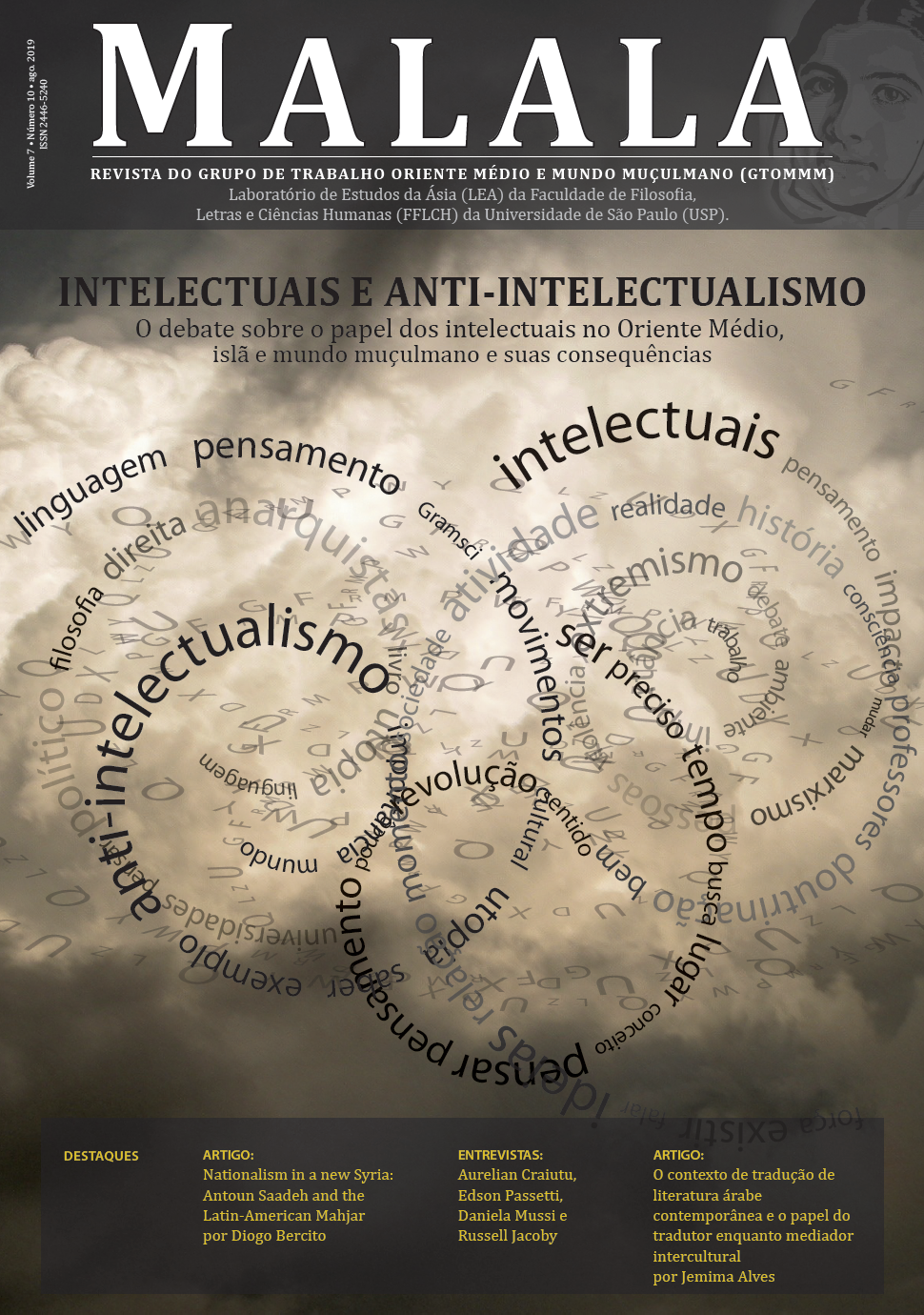The peace process in New Gaza
An analysis of the film New Gaza by Rita Martins Tragtenberg and three short stories by Jacó Guinsburg
DOI:
https://doi.org/10.11606/issn.2446-5240.malala.2019.154340Keywords:
Guinsburg, “O processo de paz”, cine and contemporary brazilian literature, New Gaza, brazilian filmAbstract
This article suggests an analysis of the film New Gaza (Brazil, 2013), written and directed by Rita Martins Tragtenberg, adapting three short stories of the book O que aconteceu, aconteceu by Jacó Guinsburg (Brazil, 2000). In New Gaza, Scholen, an orthodox Judean, has the idea of manufacture Israel and United States flags for sell to arabians protesters. Mixing drama, humor and lyricism, the film boards the conflict in Gaza and retracts the immigrant situation in Brazil. This analysis confronts the tales and the film, identifying what had been preserved, altered and recreated by the cineaste.
Downloads
References
Penguin, 1994, p. 59. http://passapalavra.info/2010/06/24723.
BENJAMIN, Walter. Obras Escolhidas I. São. Paulo: Brasiliense, 1996.
BUTLER, Judith. Caminhos divergentes: judaicidade e crítica ao sionismo. São Paulo:
Boitempo Editorial, 2017.
CANDIDO, Antonio. O discurso e a cidade. Rio de Janeiro: Ouro Sobre Azul, 2010.
CARVALHAL, Tânia Franco. Literatura comparada. 2. ed. São Paulo: Ática, 1992.
FINKELSTEIN, Norman . A indústria do Holocausto – Reflexões sobre a exploração do
sofrimento judeu. Rio de Janeiro: Record, 2001.
______. Imagem e realidade do conflito Israel-Palestina. Rio de Janeiro: Record, 2005.
GOMES, Aura Rejane. A questão da Palestina e a fundação do Estado de Israel. Dissertação
de mestrado. Universidade de São Paulo, Departamento de Ciência Política, 2001.
GUINSBURG, Jacó. O que aconteceu, aconteceu. São Paulo: Ateliê Editorial, 2001.
HARFOUSH, Jamal Mahd Hasan. A questão da Palestina e o Direito Internacional. TCC
apresentado ao Curso de Direito da Universidade de Santa Cruz do Sul, UNISC, 2016.
JAKOBSON, Roman. Linguística. Poética. Cinema. São Paulo: Perspectiva, 2007.
LUKÁCS, György. Narrar ou descrever. Marxismo e teoria da literatura. São Paulo: Expressão
Popular, 2012.
PAPPÉ, Ilan. A limpeza étnica da Palestina. São Paulo: Sundermann, 2016.
SAAB, Luciana. O projeto de paz de Oslo: considerações e críticas sobre as origens do
processo de paz Israel-Palestina (1991-1995). Mestrado pelo Programa de Pós-graduação
em Relações Internacionais San Tiago Dantas (Unesp/Unicamp/PUC-SP), São Paulo, 2016.
SAHD, Fábio Bacila. Repensar a Nakba – Os refugiados palestinos de 1948. Revista Espaço
Acadêmico, nº 135, agosto de 2012.
SAID, Edward W. A questão da Palestina. São Paulo: Editora da Unesp, 2012.
______. Cultura e imperialismo. São Paulo: Companhia das Letras, 2011.
TREISTMAN, Marcelo. Benny Morris: o que você não queria saber sobre o conflito. http://
www.conexaoisrael.org/benny-morris-e-o-fim-de-todos-os-mitos/2017-07-21/marcelo
(acesso em 9/3/2019).
TUDELA, Benjamin de. Viajes de Benjamin de Tudela (1160-1173). Trad.: Ignacio Gonzales
Llubera. Madrid: V.H. Sanz Calleja, 1918.
______. O itinerário de Benjamin de Tudela. Organização e tradução de Jacó Guinsburg. São
Paulo: Perspectiva, 2017.
XAVIER, Ismail. O olhar e a voz: a narração multifocal do cinema e a cifra da História em
São Bernardo. Literatura e Sociedade. São Paulo, n. 2, 1997.
______. Do texto ao filme: a trama, a cena e a construção do olhar no cinema. PELLEGRINI,
Tânia et al. Literatura, cinema e televisão. São Paulo: Editora Senac/Instituto Itaú Cultural,
2003.
Downloads
Published
Issue
Section
License
This journal offers free access to its content, following the principle that making free of charge-scientific knowledge available to the public provides greater worldwide democratization of knowledge. No fees will be charged for submitting work and/or publishing in the journal, as well as for reading, downloading, copying, distributing, printing, searching or referencing after publication. Readers and interested parties are free to share (copy or distribute the material in any media and format) and to transform or adapt parts of the material as long as it is for non-commercial use and the appropriate credit is given to the author and the journal, indicating how the data has been used and/or manipulated.





